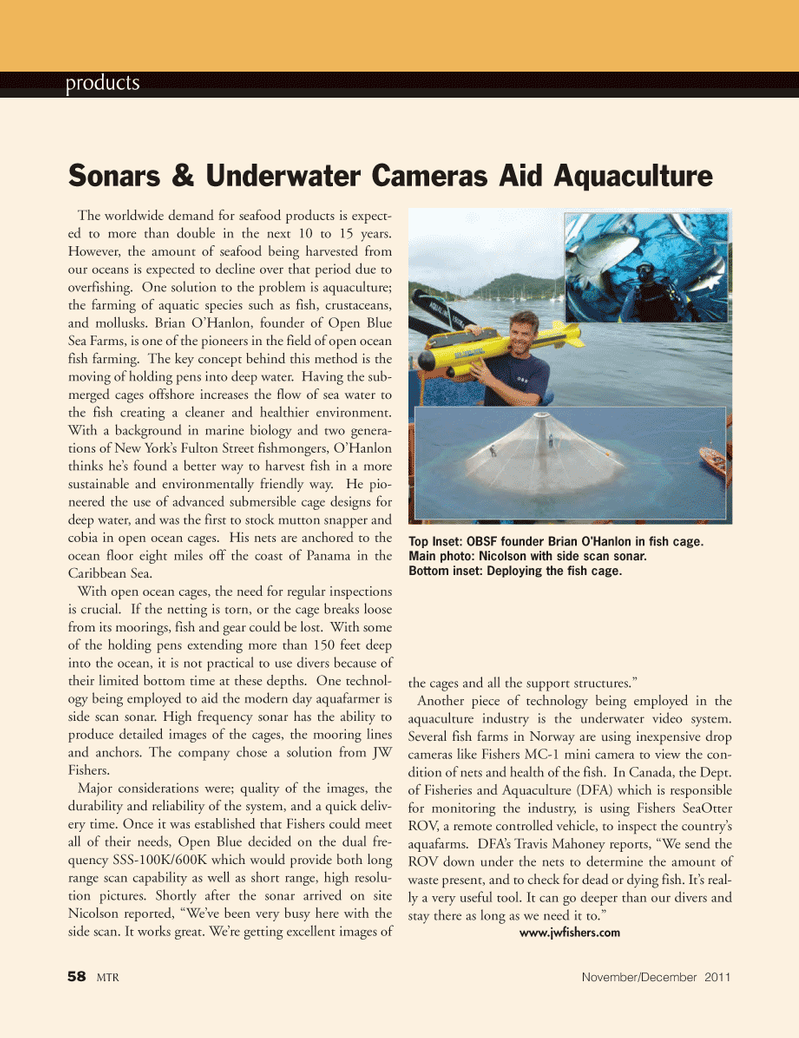
Page 58: of Marine Technology Magazine (November 2011)
FreshWater Monitoring and Sensors
Read this page in Pdf, Flash or Html5 edition of November 2011 Marine Technology Magazine
58MTRNovember/December 2011products The worldwide demand for seafood products is expect- ed to more than double in the next 10 to 15 years. However, the amount of seafood being harvested from our oceans is expected to decline over that period due to overfishing. One solution to the problem is aquaculture; the farming of aquatic species such as fish, crustaceans, and mollusks. Brian O?Hanlon, founder of Open Blue Sea Farms, is one of the pioneers in the field of open ocean fish farming. The key concept behind this method is the moving of holding pens into deep water. Having the sub- merged cages offshore increases the flow of sea water to the fish creating a cleaner and healthier environment. With a background in marine biology and two genera- tions of New York?s Fulton Street fishmongers, O?Hanlon thinks he?s found a better way to harvest fish in a more sustainable and environmentally friendly way. He pio- neered the use of advanced submersible cage designs for deep water, and was the first to stock mutton snapper and cobia in open ocean cages. His nets are anchored to the ocean floor eight miles off the coast of Panama in the Caribbean Sea. With open ocean cages, the need for regular inspections is crucial. If the netting is torn, or the cage breaks loose from its moorings, fish and gear could be lost. With some of the holding pens extending more than 150 feet deep into the ocean, it is not practical to use divers because of their limited bottom time at these depths. One technol- ogy being employed to aid the modern day aquafarmer is side scan sonar. High frequency sonar has the ability to produce detailed images of the cages, the mooring lines and anchors. The company chose a solution from JW Fishers. Major considerations were; quality of the images, the durability and reliability of the system, and a quick deliv- ery time. Once it was established that Fishers could meet all of their needs, Open Blue decided on the dual fre- quency SSS-100K/600K which would provide both long range scan capability as well as short range, high resolu- tion pictures. Shortly after the sonar arrived on site Nicolson reported, ?We?ve been very busy here with the side scan. It works great. We?re getting excellent images of the cages and all the support structures.? Another piece of technology being employed in the aquaculture industry is the underwater video system. Several fish farms in Norway are using inexpensive drop cameras like Fishers MC-1 mini camera to view the con- dition of nets and health of the fish. In Canada, the Dept. of Fisheries and Aquaculture (DFA) which is responsible for monitoring the industry, is using Fishers SeaOtter ROV, a remote controlled vehicle, to inspect the country?s aquafarms. DFA?s Travis Mahoney reports, ?We send the ROV down under the nets to determine the amount of waste present, and to check for dead or dying fish. It?s real- ly a very useful tool. It can go deeper than our divers and stay there as long as we need it to.? www.jwfishers.com Top Inset: OBSF founder Brian O'Hanlon in fish cage. Main photo: Nicolson with side scan sonar. Bottom inset: Deploying the fish cage.Sonars & Underwater Cameras Aid Aquaculture MTR#9 (50-64):MTR Layouts 11/29/2011 9:37 AM Page 58

 57
57

 59
59
